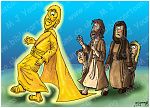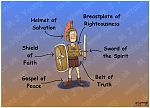Bible Cartoon: <-- Galatians : Ephesians -->
Click on Add to cart button below shopping cart.
Purchased Bible Cartoons do not have watermarks. Links to Cartoons provided on email once purchase is completed.Ephesians
Book type: Letter (Epistle)
Author: Apostle Paul
No. of chapters: 6
Key character(s): God, Jesus, Paul, Tychicus [1]
Brief description: Ephesians – Unity in Christ.
01) The apostle sends greetings to the church (1:1-2)
02) Believers who make up the church have a great potential in Christ (1:3-3:21)
03) Believers need to practice their faith (4:1-6:20)
04) The apostle concludes his letter with a personal word of encouragement (6:21-6:24)
How do you find victory in Christ? This question becomes especially acute when problems become evident in the church.
01) The heathen religions had to be reckoned with as powerful & growing forces.
02) Internal bickering threatened the church itself.
03) The allure of the world attempted to claim the allegiance of believers because their vocational & financial success was often wrapped up in how they related to the secular world.
It is a widely hld belief that the words of Paul in this writing were meant for a wider audience than just the believers in Ephesus. The letter was probably a “circular letter” sent to many churches & assemblies of believers in Asia Minor.
Theological conclusions.
Ephesians may be considered a manual of Christian living.
Five major doctrinal issues are emphasised in Ephesians:
01) Believers have position in Christ.
02) Believers have a new nature (see Ephesians 2:1-10).
03) As a result of point 02), believers now have the possibility of a very real unity in the “body of Christ”, the church.
04) Ephesians points out the importance of a holy, separated life.
05) Ephesians teaches that family life & vocational life are spiritual issues.
Contemporary teaching.
01) We need to live from a positive perspective.
02) We need to maintain unity within the Christian fellowship at the expense of personal prejudices, but stop short of spiritual compromise.
03) A life of holiness & separation from the world needs to be a continuing Christian distinctive.
04) We need to carry our faith over into all the relationships of life & especially into those relationships involving family & vocation, since they consume the greatest part of our time & energy.
[Source: NIV Disciple’s Study Bible]
What does the ideal Christian church look like? How should Christians behave?
These important questions are answered in the book of Ephesians. This instructional letter is packed with practical advice, all given in an encouraging tone. Ephesians also contains two of the most memorable passages in the New Testament: the doctrine that salvation comes by grace alone through faith in Jesus Christ, and the metaphor of the Full Armor of God.
Today, 2,000 years later, Christians are still debating a controversial passage in Ephesians commanding wives to submit to their husbands and husbands to love their wives (Ephesians 5:22-33).
Themes in the Book of Ephesians:
Christ has reconciled the whole of creation to himself and to God the Father.
People of all nations are united to Christ and to one another in the church, through the working of the Trinity. Paul uses several word pictures to describe the church: body, temple, mystery, new man, bride, and soldier.
Christians should lead holy lives that give honor to God. Paul issues specific guidelines for right living.
[Source:http://christianity.about.com/od/newtestamentbooks/a/Ephesians.htm]
Key Verses:
Ephesians 2:8-9 (ANIV)
For it is by grace you have been saved, through faith-and this is not from yourselves, it is the gift of God-not by works, so that no one can boast.
Ephesians 4:4-6 (ANIV)
There is one body and one Spirit, just as you were called to one hope when you were called; one Lord, one faith, one baptism; one God and Father of all, who is over all and through all and in all. (NIV)
Ephesians 5:22, 28 (ANIV)
Wives, submit yourselves to your own husbands as you do to the Lord…In this same way, husbands ought to love their wives as their own bodies. He who loves his wife loves himself. (NIV)
Ephesians 6:11-12 (ANIV)
Put on the full armor of God, so that you can take your stand against the devil’s schemes. For our struggle is not against flesh and blood, but against the rulers, against the authorities, against the powers of this dark world and against the spiritual forces of evil in the heavenly realms. (NIV)
[1]
Fuller list of major characters in the Ephesians:
| Name | Notes |
| Jesus | ”Saviour”. Christ means “the Anointed One”. (aka Jesus of Nazareth, The Christ, The Messiah, Son of man, Son of God). The central figure of the New Testament, whose life, death, and resurrection are chronicled in the 4 Gospel books. |
| Paul | (aka Saul, “Asked for” Hebrew.) Native of Tarsus, the capital of Cilicia, a Roman province in the south-east of Asia Minor. Jew with Roman citizenship; Pharisee; persecutor of the early Christian church. Converted from Judaism to Christianity after encounter with resurrected Jesus on the road to Damascus (Acts 9:1-30). Thereafter called an apostle (Ro 1:1, 1Co 1:1, 2Co 1:1, Gal 1:1, Eph 1:, Col 1:1, 1Ti 1:1, 2Ti 1:1, Tit 1:1). Author of at least 13 of the 27 books of the New Testament: Romans, Phillipians, 1 & 2 Timothy, 1 & 2 Corinthians, Colossians, Titus, 1 & 2 Thessalonians, Philemon, Galatians, Ephesians. |
| Tychicus | Τύχικος, Túchikos, literally “chance” or “fortuitous”). An Asiatic Christian, mentioned 5 times in the New Testament (Acts 20:4; Ephesians 6:21; Col. 4:7; 2 Timothy 4:12; Titus 3:12). A friend and companion of the apostle Paul on his 3rd missionary journey. Described as “a faithful minister in the Lord” (Ephesians 6:21, 22), who, with Trophimus, accompanied Paul on a part of his journey from Macedonia to Jerusalem (Acts 20:4). He is alluded to also in Col 4:7; Tit 3:12, and 2 Timothy 4:12 as having been with Paul at Rome. Paul sent him to Ephesus, probably for the purpose of encouraging & building up the church there. |





